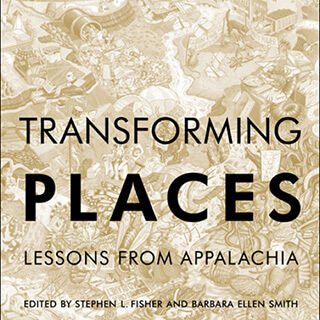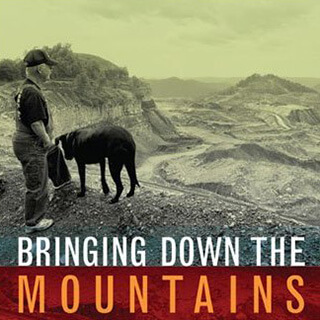Overview
Denise Giardina evokes the physical and emotional landscapes of mountain top removal in this excerpt from her novel, Fallam's Secret.
"New Shades o'Death Creek" is part of the 2008 Southern Spaces series "Space, Place, and Appalachia," a collection of publications exploring Appalachian geographies through multimedia presentations.
Excerpt
Set in West Virginia, this excerpt from Giardina's novel of time-space travel, Fallam's Secret (2003), evokes the physical and emotional landscapes of mountaintop removal in the southern Appalachians.
On the way home Lydde said, "I want to see the mountains now. Or what's left."
Aunt Lavinia pressed her lips together and nodded. When they were close to the Mystery Hole she said, "Take the Old Road down into the gorge and cross to that overlook on Gauley that John used to like so much."
 |
| Earl Dotter, Mountaintop removal mine site above McRoberts, Kentucky, 2005. |
The Old Road had once been the only way to Charleston, before the four-lane highway — still new to Lydde — went in. They wound down hairpin curves to the river, crossed on a new concrete bridge, and climbed the other side of the gorge on Gauley Mountain to the wide shoulder where Uncle John had liked to stop and "rest his eyes." When they pulled onto the dirt shoulder and stopped, Lydde saw at last what her uncle had been talking about, what had so upset Aunt Lavinia. She opened the car door and stepped out, scarcely able to breathe. Once there had been mountain after mountain, shedding fog in the morning, soaking up light and turning it to purple and gray and green in the evening. Once there had been mountains higher even than the one on which they now stood. Now there was empty sky. Reluctantly Lydde dropped her eyes, lower, lower, to a vast plain of grass and rock. Where the crest of Fallam had been, past where Black had been, and Droop, stretched a flat featureless scape, dotted here and there by a gray pond. At the near edge a few stunted trees clung to life.
"How big is it?" Lydde whispered when she could speak."
"Four square miles for this one," Aunt Lavinia said. "And it goes on farther than you can see. They blew apart the mountains and they filled in the streams and hollows. The blasting was terrible. Enough explosives to blow up Manhattan, John told me. All those trees, and the poor animals too." She shook her head. "They destroyed the groundwater down below, of course, and the people with wells lost those. And the dust — just be glad you weren't here. White silica dust. It coated everything. The trees around us looked like they'd been sprinkled with confectioner's sugar."
"So people left," Lydde said.
"Bought out by the coal company. Everyone except John. He refused to sell. They weren't going to cover us up like some of the other places, he said, because we were near the River. So he was hanging on. Besides, before they bought people out they made everyone sign a deed saying they would never live in this county again, not for the rest of their natural lives. John said no one would ever get him to sign such a thing. You know how stubborn he could be."
"Well, you hung on," Lydde said, trying to see something good in the situation. "And from the farm you can't see this." But you know it's there, she thought, and it eats at you.
"That's not all," said Aunt Lavinia. "I wish it was. But after the blasting was done, after the dust settled, we had an inspector in. The foundation is cracked. Ten, twenty years from now everything will be falling in. I'll never be able to sell. So I'll stay, and I reckon the house will outlast me, but just barely."
Roundbottom Farm. Built in 1840, now on Death Row. With the spring vegetation, it was hidden just then, but Lydde knew where it was, behind a fold of land down and to the left. Farther east, once midway up the mountain and now at the top edge, was the familiar jutting rock of Fallam Point.
"Is Montefalco totally gone?"
 |
| Earl Dotter, Oldhouse Branch Refuse Valley Fill Impoundment, Enterprise Mining Company, Letcher County, Kentucky, 2005. |
"You can walk up there and see," said Aunt Lavinia said. "Myself, I don't want to go again. The valley fill starts right there where the house was."
"Valley fill."
"A nice word for taking what's left of the top of the mountain and throwing it over the side and covering up the head of Shades o'Death Creek. The creek floods down below and it never did before. We had water in the house two years ago."
Lydde sighed. "I guess I'll have to go look at it just to get an idea of what they've done."
"Oh, you'll see. If the Devil built a fortress in the middle of your daddy's land, that's what it would look like."
Lydde didn't believe in the Devil. But when she had climbed the gravel road above the Mystery Hole, hoping against reality that she would find the foundation again, she thought of the book she had devoured three times in her high school years, The Lord of the Rings. "The land of Mordor," she said aloud. They were appealing to different literary metaphors, she and Aunt Lavinia, but speaking of the same thing. Blocking her way was a gigantic terrace, a pyramid of obscene size, each level the height of a five story building. A straight channel lined with rocks cut its way straight down the middle. The new Shades o'Death Creek.
Somewhere beneath that massive pile that Lydde had to crane her neck to glimpse the top of, somewhere beneath it Carlo Falcone had tried to raise goats and pigs and grapevines, and Lydde had lived with her family.
She had been carrying a stick, a talisman of hope, to dig with. She dropped it. Fallam Mountain, old as creation, had found its own grave atop the remains of her family's pyre. 
| Emily Satterwhite, Aerial view of mountaintop removal site, Southern West Virginia, 2005. |
About the Author
Appalachian native Denise Giardina writes historical fiction that explores theological questions. Among her books are Storming Heaven (1987), Saints and Villains (1998), The Unquiet Earth (1987), and Emily's Ghost (2009). Giardina is an ordained Episcopal Church deacon, a community activist, and a former candidate for the West Virgina governorship. This excerpt from Fallam's Secret is used with the permission of the author
Recommended Resources
Appalachian Mountain Advocates
Coal River Mountain Watch
http://www.crmw.net/
Earl Dotter, Coalfield Generations: Health, Mining, and the Environment.
I Love Mountains
http://www.ilovemountains.org/
Mountain Justice
https://mountainjustice.org/
Ohio Valley Environmental Coalition




